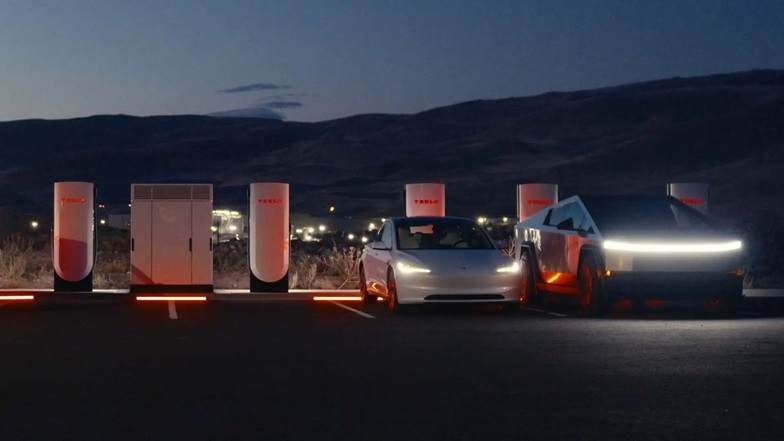Tesla has been at the forefront of EV innovation, and its Supercharger network has long been the gold standard for reliable and convenient charging. With thousands of stalls across North America, Tesla drivers have enjoyed unparalleled access to fast, user-friendly charging for long road trips. Now, the introduction of the new V4 Supercharger Cabinet marks another leap forward, addressing charging speed limitations and efficiency challenges. Here’s how this upgrade is reshaping the EV charging landscape.

Tesla’s Supercharger Legacy
Since the first Supercharger launched in 2012, Tesla has consistently pushed the boundaries of charging technology. Back then, the stations delivered a maximum of 90 kW per vehicle—a far cry from the 250 kW supported by today’s V3 cabinets. This growth has made Tesla’s network a reliable option for quick and efficient charging.
However, as EV technology evolves, newer vehicles like the Tesla Cybertruck (800V battery) and the Lucid Air (900V battery) demand even faster and higher-voltage charging. The V3 cabinets, capped at 500V per stall, created bottlenecks for these cutting-edge vehicles. Enter the V4 Supercharger Cabinet, a game-changer designed to support charging systems from 400V to 1,000V, delivering faster, more efficient charging for the next generation of EVs.
Key Features of the V4 Supercharger Cabinet
1- Higher Power Output
- The V4 Cabinet boosts charging speeds significantly:
- Tesla Cybertruck: Up to 500 kW (30% faster than before).
- Tesla Semi: A massive 1.2 Megawatts for heavy-duty needs.
- Other Tesla vehicles, such as the Model 3 and Model Y, remain capped at 250 kW, maintaining compatibility with older charging systems.
2- Enhanced Efficiency
- The V4 Cabinet achieves a 2% efficiency improvement over its predecessor.
- Considering Tesla’s network delivers over 5 terawatt-hours of energy annually, this small boost translates to 100 gigawatt-hours/year in energy savings by reducing waste heat.
3- Compact Design and Increased Capacity
- The new cabinet has a smaller footprint but packs more power, enabling it to support up to eight stalls per unit—double the capacity of the V3.
- Simplified design eliminates the need for DC busbars, reducing complexity and increasing reliability.
- The V4 Cabinet is tailored for vehicles using advanced battery systems, making it a critical upgrade for future Tesla models and non-Tesla EVs.
V3 vs. V4 Supercharger Cabinets
| Feature | V3 Cabinet | V4 Cabinet |
|---|---|---|
| Max Voltage | 500V | 1,000V |
| Max Power (Cybertruck) | Not supported | 500 kW |
| Max Power (Tesla Semi) | Not supported | 1.2 MW |
| Stalls Powered per Unit | 4 | 8 |
| Efficiency | Standard | 2% higher |
| Complexity | Requires DC busbars | Simplified electronics |
Tesla’s V4 cabinets not only improve performance but also enhance scalability and reduce costs, ensuring the network remains the industry leader.
The Environmental Impact
Tesla’s 2% efficiency improvement might seem minor, but when scaled to the Supercharger network’s massive output, it results in substantial energy savings. By conserving 100 GWh of energy annually, the upgrade reduces waste heat and lowers the overall carbon footprint of the network, aligning with Tesla’s mission to accelerate the transition to sustainable energy.
What This Means for EV Owners
Faster Charging for Next-Gen Vehicles
The V4 Cabinet ensures that newer EVs like the Cybertruck, Lucid Air, and Tesla Semi can fully utilize their advanced battery architectures. This translates to shorter charging stops for long-haul travel.
More Stalls, Less Waiting
With the ability to power eight stalls per cabinet, Tesla is effectively doubling the capacity of its stations. This upgrade will reduce wait times during peak hours, offering a smoother charging experience.
Compatibility Across Brands
As Tesla opens its Supercharger network to non-Tesla EVs, the V4 Cabinet’s ability to handle a wide voltage range makes it compatible with a broader range of vehicles, from 400V systems to 1,000V setups.
A Look Back: How Far Superchargers Have Come
Tesla’s charging journey began over a decade ago, with a focus on making EVs viable for long-distance travel. Here’s how the network has evolved:
| Year | Key Milestone | Max Output |
|---|---|---|
| 2012 | First Supercharger launched | 90 kW |
| 2019 | V3 Supercharger introduced | 250 kW |
| 2023 | V4 Cabinet announced | 1,200 kW (for Tesla Semi) |
Tesla’s continuous innovation ensures its network remains not just functional but also ahead of the competition.
The Road Ahead
The first V4 Supercharger stations are expected to open in 2024, signaling a new era in EV charging. With Tesla’s focus on improving efficiency, expanding capacity, and supporting next-gen vehicles, the V4 Cabinet is set to solidify its place as the benchmark in EV charging infrastructure.
For Tesla drivers and other EV owners, this upgrade promises shorter charging times, fewer delays, and a more seamless driving experience. Tesla’s relentless innovation continues to pave the way for a sustainable, electrified future.
The V4 Supercharger Cabinet is more than just an upgrade—it’s a statement of Tesla’s commitment to staying ahead in the EV charging game. By combining speed, efficiency, and scalability, Tesla is ensuring that its Supercharger network will remain the go-to choice for EV owners, now and in the future.
Related Post
